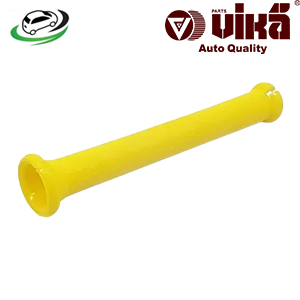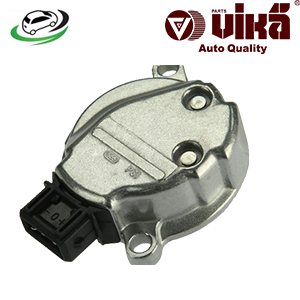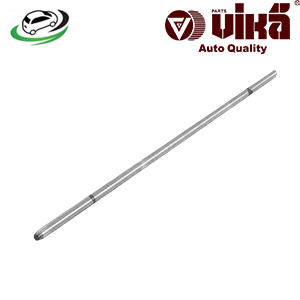-20%
Get Clutch Push Rod VW Rabbit/ Cabrio/ Golf/ Jetta/ Cabriolet/ Rabbit Pickup/ Scirocco/ Rabbit Convertible 020141741B
The clutch push rod is a critical component in the clutch system of a vehicle. It plays a fundamental role in transmitting force from the clutch pedal to the clutch mechanism, enabling smooth engagement and disengagement of the clutch. This article provides a comprehensive overview of the clutch push rod, including its function, construction, importance, and maintenance.
Function of the Clutch Push Rod
The clutch push rod is responsible for transmitting the mechanical force exerted by the driver’s foot on the clutch pedal to the clutch mechanism, specifically the clutch release bearing or fork. Its primary functions are:
- Force Transmission: When the driver presses the clutch pedal, the push rod transfers this force through a series of linkages or hydraulic mechanisms to the clutch release mechanism. This action disengages the clutch from the engine, allowing the driver to shift gears smoothly.
- Engagement and Disengagement: The push rod plays a crucial role in engaging and disengaging the clutch. When the pedal is released, the push rod helps reapply pressure to the clutch pressure plate, re-engaging the clutch and allowing power to be transmitted from the engine to the transmission.
- Clutch Adjustment: In some vehicles, the push rod is adjustable, allowing for fine-tuning of the clutch engagement and disengagement points. Proper adjustment ensures that the clutch operates smoothly and effectively.
Construction of the Clutch Push Rod
The clutch push rod is designed to be durable and capable of withstanding the forces involved in clutch operation. Its construction includes several key components:
- Material:
- Steel: Most clutch push rods are made from high-strength steel to ensure durability and resistance to bending or deformation under load.
- Aluminum: In some performance or lightweight applications, aluminum push rods may be used for reduced weight, though they are typically less common than steel.
- Design:
- Rod Shape: The push rod is typically a cylindrical or slightly tapered rod that connects the clutch pedal assembly to the clutch release mechanism. Its design ensures efficient transfer of force.
- Ends: The ends of the push rod often have various fittings, such as ball joints, forked ends, or threaded ends, depending on the design of the clutch system. These fittings connect the push rod to other components, such as the clutch pedal or release bearing.
- Adjustability: Some push rods are designed with adjustable lengths or threaded ends to allow for precise adjustment of the clutch engagement point. This feature helps in fine-tuning the clutch operation and accommodating wear or changes in the clutch system.
Importance of the Clutch Push Rod
- Smooth Clutch Operation: The push rod is essential for smooth and reliable clutch operation. By transferring the force from the clutch pedal to the clutch mechanism, it ensures that the clutch engages and disengages correctly, allowing for smooth gear changes.
- Driving Comfort: Properly functioning push rods contribute to a more comfortable driving experience by ensuring that the clutch operates smoothly and consistently. This helps prevent issues such as hard or inconsistent clutch engagement, which can affect drivability and comfort.
- Clutch Longevity: A well-maintained push rod helps in reducing wear and tear on the clutch system. By ensuring that the clutch operates correctly, it can help extend the lifespan of the clutch components and prevent premature failures.
- Safety: Efficient clutch operation is crucial for safe driving. A malfunctioning or improperly adjusted push rod can lead to difficulties in shifting gears, which may impact vehicle control and safety. Proper maintenance and adjustment of the push rod contribute to overall driving safety.
Signs of a Faulty Clutch Push Rod
- Difficulty in Shifting Gears: If you experience difficulty in shifting gears, it could be a sign of a faulty or misaligned push rod. This issue may result in hard or sticky shifts, indicating that the clutch is not disengaging properly.
- Clutch Slippage: If the clutch slips, meaning it fails to fully engage or disengage, it may be due to a problem with the push rod. Clutch slippage can cause a loss of power transfer and reduced vehicle performance.
- Unusual Noises: Grinding, rattling, or squeaking noises when the clutch is engaged or disengaged may indicate issues with the push rod or related components. These noises can signal that the push rod is not functioning correctly or that there is an issue with the clutch mechanism.
- Pedal Feel Issues: If the clutch pedal feels too soft, too hard, or inconsistent, it may be related to the push rod. Proper adjustment and function of the push rod are crucial for maintaining a comfortable and responsive pedal feel.
- Increased Clutch Wear: Premature wear of the clutch components, such as the clutch disc or pressure plate, can result from a faulty push rod. If the push rod is not functioning correctly, it can cause uneven engagement or disengagement of the clutch, leading to increased wear on other parts.
Maintenance and Care
- Regular Inspection: Regularly inspect the clutch push rod for signs of wear, damage, or misalignment. Look for any visible cracks, bends, or other issues that may affect its function. During routine maintenance, check the push rod for proper adjustment and operation.
- Lubrication: Ensure that any moving parts associated with the push rod, such as ball joints or pivot points, are properly lubricated. Proper lubrication helps reduce friction and wear, ensuring smooth operation of the push rod.
- Adjustment: If the push rod is adjustable, ensure that it is set to the correct length or position according to the manufacturer’s specifications. Proper adjustment helps maintain optimal clutch performance and prevents issues such as hard shifting or clutch slippage.
- Replace Worn Components: If the push rod shows signs of significant wear or damage, it should be replaced promptly. Continuing to use a faulty push rod can lead to further damage to the clutch system and other related components.
- Check for System Issues: If you experience problems with the clutch, such as difficulty shifting or unusual pedal feel, have the entire clutch system checked by a professional. Issues with the push rod may be symptomatic of broader problems within the clutch system.
Replacing the Clutch Push Rod
Replacing a faulty clutch push rod is a straightforward process that involves several key steps:
- Preparation: Ensure the vehicle is safely lifted and supported on jack stands. Disconnect the battery and ensure the engine is cool before starting the replacement process.
- Access the Push Rod: Locate the clutch push rod within the engine compartment. Depending on the vehicle, it may be necessary to remove other components or covers to access the push rod.
- Remove the Old Push Rod: Disconnect the push rod from the clutch pedal assembly and the clutch release mechanism. Carefully remove any retaining clips or fasteners holding the push rod in place.
- Install the New Push Rod: Position the new push rod in place and secure it to the clutch pedal assembly and release mechanism. Ensure that it is properly aligned and connected.
- Adjust the Push Rod: If the push rod is adjustable, set it to the correct length or position as per the manufacturer’s specifications. This step ensures that the clutch operates smoothly and effectively.
- Reassemble and Test: Reinstall any components or covers that were removed to access the push rod. Reconnect the battery and test the clutch operation to ensure that it is functioning correctly.
Follow us on Facebook for more parts.



